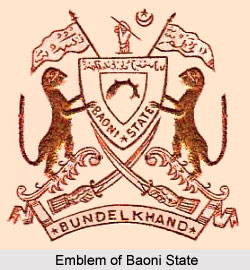 The Princely State of Baoni was among the 11 Gun Salute states of India that existed during the rule of the British Empire in India. In the early 19th century, the state was appointed as one of the princely states of India under the indirect rule of the British Government of India. At present the state is located in the modern Indian state of Uttar Pradesh. Baoni state was scattered over a total area of 121 sq miles and comprised of a population of 25,256 in the year 1941. The former native state of Baoni was also known as Kadaura, which was the name of its capital. It included almost 52 villages and was located in Bundelkhand. Baoni state was incorporated as a part of the Bundelkhand Agency under the Central India Agency.
The Princely State of Baoni was among the 11 Gun Salute states of India that existed during the rule of the British Empire in India. In the early 19th century, the state was appointed as one of the princely states of India under the indirect rule of the British Government of India. At present the state is located in the modern Indian state of Uttar Pradesh. Baoni state was scattered over a total area of 121 sq miles and comprised of a population of 25,256 in the year 1941. The former native state of Baoni was also known as Kadaura, which was the name of its capital. It included almost 52 villages and was located in Bundelkhand. Baoni state was incorporated as a part of the Bundelkhand Agency under the Central India Agency.
The Princely State of Baoni was an enclave in the United Provinces of Agra and Oudh under the British dominion. It was bordered by the district of Cawnpore in the north; by Jalaun in the west; and by the district of Hamirpur on all other sides of the state. The region also partly shared its border with the smaller state of Beri. The princely state of Baoni was appointed as one of the salute states of India and was granted a gun salute of 11 guns. The native ruler of the princely state, who held the title of Nawab, held full judicial and administrative powers.
The descendants of the Asaf Jahi family of Hyderabad were the ruling family of Baoni. The state was established by grandson of the first nizam of the Mughal dynasty, named Imad il mulk Ghazi Uddin, around 1784. The Peshwa granted him52 villages in Bundelkhand. The name of the state was derived from the word "Bawan", which means fifty two, denoting the number of villages granted by the original sanad. The British East India Company recognized the validity of this grant in the year 1806 and reassigned 3 of the rural villages which were seized earlier by the Maratha Empire. The last Nawab of the state was the 8th native ruler of his line.
After the country gained independence and the partition of India on 15th August 1947, the native ruler acceded his state to the newly formed Union of India, also known as the Dominion of India.



















